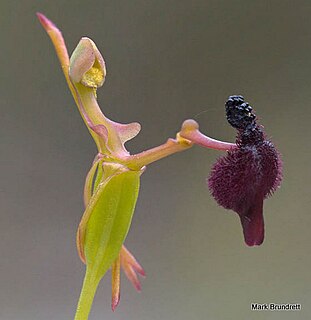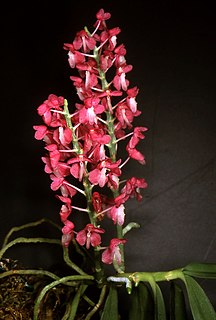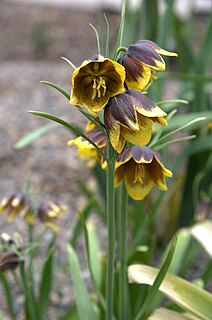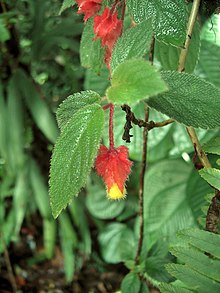
Royal Botanic Gardens, Kew, is a non-departmental public body in the United Kingdom sponsored by the Department for Environment, Food and Rural Affairs. An internationally important botanical research and education institution, it employs 1,100 staff. Its board of trustees is chaired by Dame Amelia Fawcett.

Gesneriaceae, the gesneriad family, is a family of flowering plants consisting of about 152 genera and ca. 3,540 species in the tropics and subtropics of the Old World and the New World, with a very small number extending to temperate areas. Many species have colorful and showy flowers and are cultivated as ornamental plants.

Drakaea is a genus of 10 species in the plant family Orchidaceae commonly known as hammer orchids. All ten species only occur in the south-west of Western Australia. Hammer orchids are characterised by an insectoid labellum that is attached to a narrow, hinged stem, which holds it aloft. The stem can only hinge backwards, where the broadly winged column carries the pollen and stigma. Each species of hammer orchid is pollinated by a specific species of thynnid wasp. Thynnid wasps are unusual in that the female is flightless and mating occurs when the male carries a female away to a source of food. The labellum of the orchid resembles a female thynnid wasp in shape, colour and scent. Insect pollination involving sexual attraction is common in orchids but the interaction between the male thynnid wasp and the hammer orchid is unique in that it involves the insect trying to fly away with a part of the flower.

Andropogon is a widespread genus of plants in the grass family, native to much of Asia, Africa, and the Americas as well as southern Europe and various oceanic islands.

Trillium pusillum is a species of flowering plant in the family Melanthiaceae known by the common names dwarf trillium, least trillium and dwarf wakerobin. It is native to the southeastern and south-central United States from Oklahoma to Maryland.

Phenakospermum is a monotypic genus in the family Strelitziaceae. Only one species is recognized, Phenakospermum guyannense, native to Surinam, French Guyane and the eastern Amazon River basin. This plant grows to over 10 m in height but can be felled with a single blow with a machete.
Typhonium mirabile is a species of flowering plant in the family Araceae. It is found growing in Australia in eucalypts woodlands at the base of Cycas plants. It was first described in 1992 by Alistair Hay, as Lazarum mirabile and was the only species in the genus Lazarum. In 1997, Hay published a paper transferring it to the genus Typhonium.

Dendrobium bigibbum, commonly known as the Cooktown orchid or mauve butterfly orchid, is an epiphytic or lithophytic orchid in the family Orchidaceae. It has cylindrical pseudobulbs, each with between three and five green or purplish leaves and arching flowering stems with up to twenty, usually lilac-purple flowers. It occurs in tropical North Queensland, Australia and New Guinea.

Dendrobium discolor, commonly known as antler orchids, are epiphytic or lithophytic orchids in the family Orchidaceae. They have cylindrical pseudobulbs, each with between ten and thirty five leathery leaves, and flowering stems with up to forty mostly brownish or greenish flowers with wavy and twisted sepals and petals. Antler orchids occur in northern Australia, New Guinea and Indonesia and there are several subspecies and varieties.

Acer heldreichii is a species of flowering plant in the Sapindaceae family. It is referred to by the common names Heldreich's maple, Mountain Maple, Greek maple, and Balkan maple is a European species of maple. It is native to Greece, Bulgaria, Romania, Albania, North Macedonia, Montenegro, Kosovo, Serbia, and Bosnia-Herzegovina.

Haberlea is a monotypic genus of flowering plants in the family Gesneriaceae. The only member of this genus, Haberlea rhodopensis, is endemic to parts of Bulgaria and a small part of northern Greece, especially in the Rhodope Mountains. Common names include Orpheus flower and resurrection plant because of the remarkable ability of Haberlea to survive very long periods of desiccation.
The World Checklist of Selected Plant Families is an "international collaborative programme that provides the latest peer reviewed and published opinions on the accepted scientific names and synonyms of selected plant families." Maintained by the Royal Botanic Gardens, Kew, it is available online, allowing searches for the names of families, genera and species, as well as the ability to create checklists.
Premna barbata is a plant species in the genus Premna, first described in 1847. It is native to Myanmar and to the Indian Subcontinent.

Allium libani is a species of wild bulbous plant geophyte of the genus Allium, belonging to the family of Amaryllidaceae. Allium libani is endemic to the Middle East in Lebanon and Syria.

Dyakia is a genus of orchids. It contains only one species, Dyakia hendersoniana(Rchb.f.) Christenson, endemic to the Island of Borneo.
Afrocalathea is a genus of plants native to Africa. It contains only one species: Afrocalathea rhizantha (K.Schum.) K.Schum, known from Nigeria, Cameroon, Gabon, Cabinda, and Congo-Brazzaville.

Melaleuca glauca, commonly known as Albany bottlebrush is a plant in the myrtle family, Myrtaceae and is endemic to the south-west of Western Australia. It is a tall shrub with glaucous leaves and spikes of red flowers in spring.

Fritillaria reuteri is a perennial herbaceous bulbous plant, distributed in Turkey and Iran. It is a species in the genus Fritillaria, in the family Liliaceae. It is placed in the subgenus Fritillaria.

Eriocapitella tomentosa, a species of flowering plant in the buttercup family Ranunculaceae, is native to Asia. The specific epithet tomentosa means "thickly matted with hairs, tomentum (padding)". In Chinese, a common name is da huo cao, which means "fire grass" or "fireweed".

Xantolis tomentosa, the wooly ironwood, is a forest tree commonly found in India, Sri Lanka and a few other nearby countries.
















